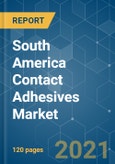South America contact adhesives market is expected to grow at a CAGR of more than 2% during the forecast period. The demand for contact adhesives is widely driven by the recovery in construction activities and increased application in automotive and aerospace industry for producing lightweight vehicles and aircrafts. However, stringent VOC emission regulations may affect the growth of the studied market.
Key Market Trends
Building and Construction Industry to Drive the Market Demand
Brazil to Dominate the Market
Competitive Landscape
South America contact adhesives market is fragmented in nature. Some of the key players in the market includes 3M, Arkema Group, H.B. Fuller, Sika AG, and Henkel AG & Co. KGaA, amongst others.
Reasons to Purchase this report:
This product will be delivered within 2 business days.
- The neoprene-based segment dominated the market. It is likely to grow during the forecast period, owing to the rising demand from the footwear and construction industry.
- The shifting focus toward water-borne adhesives is likely to offer opportunities for the contact adhesives market in the region.
- Brazil stands to be the largest market for contact adhesives in the region, with consumption being majorly driven by the demand from end-user industries, such as packaging, construction, woodworking and footwear.
Key Market Trends
Building and Construction Industry to Drive the Market Demand
- Contact adhesives’ properties such as good cohesion, adhesion and elasticity, high cohesive strength, flexibility, high elastic modulus of substrate, resistance from thermal expansion, environmental resistance from UV light, corrosion, salt water, rain, and other weathering conditions, makes it extensively useful for application in construction industry.
- They are mainly used in wooden flooring and artificial turf, owing to their property of strain crystallization.
- With economies reviving from economic slowdown caused due to corruption, political instability and lack of investment, the construction industry in the region has been recovering at a steady pace.
- Hence, with growing construction activities in countries, such as Brazil, Columbia, Chile and Peru are likely to drive the consumption of contact adhesives market in the region.
Brazil to Dominate the Market
- In terms of consumption, Brazil stands to be the largest market for contact adhesives in the region. Brazil had experienced a volatile economy over the past few years.
- Political instability, high inflation, low prices of export of goods, and depressed confidence levels caused a contraction in the Brazilian economy.
- However, the country’s economic growth is now supported by the recovery in various end-user industries, such as automotive and construction.
- Currently, the country’s infrastructure sector is under flux. However, the government has introduced a program for infrastructure development to help leverage private sector logistics investment, which is likely to increase the scope for consumption of contact adhesive in the country during the forecast period.
- Brazil retail sector stands to be the largest in the region which accounts for more than 35% of the regional retail sales. The sector is further witnessing noticeable growth in the country with growing demand for food and consumer goods.
- Hence, all such trends are expected to drive the consumption of contact adhesives market in the country during the forecast period.
Competitive Landscape
South America contact adhesives market is fragmented in nature. Some of the key players in the market includes 3M, Arkema Group, H.B. Fuller, Sika AG, and Henkel AG & Co. KGaA, amongst others.
Reasons to Purchase this report:
- The market estimate (ME) sheet in Excel format
- 3 months of analyst support
This product will be delivered within 2 business days.
Table of Contents
1 INTRODUCTION
4 MARKET DYNAMICS
5 MARKET SEGMENTATION
6 COMPETITIVE LANDSCAPE
7 MARKET OPPORTUNITIES AND FUTURE TRENDS
Companies Mentioned (Partial List)
A selection of companies mentioned in this report includes, but is not limited to:
- 3M
- Arkema Group
- Ashland
- Avery Dennison Corporation
- Beardow Adams
- Dow
- Dymax Corporation
- Franklin International
- H.B. Fuller
- Henkel AG & Co. KGaA
- Huntsman International LLC
- ITW Performance Polymers (Illinois Tool Works Inc.)
- Jowat AG
- Mapei Inc.
- Sika AG
Methodology

LOADING...








